When I first discovered that the best plants for air purification in bedrooms were actually backed by NASA research, my entire perspective on indoor gardening changed forever. After struggling with restless nights and stuffy bedroom air for months, I decided to investigate what science had to say about plants and sleep quality. What I found was groundbreaking research from NASA’s Clean Air Study that identified specific plants capable of removing harmful toxins while you sleep.
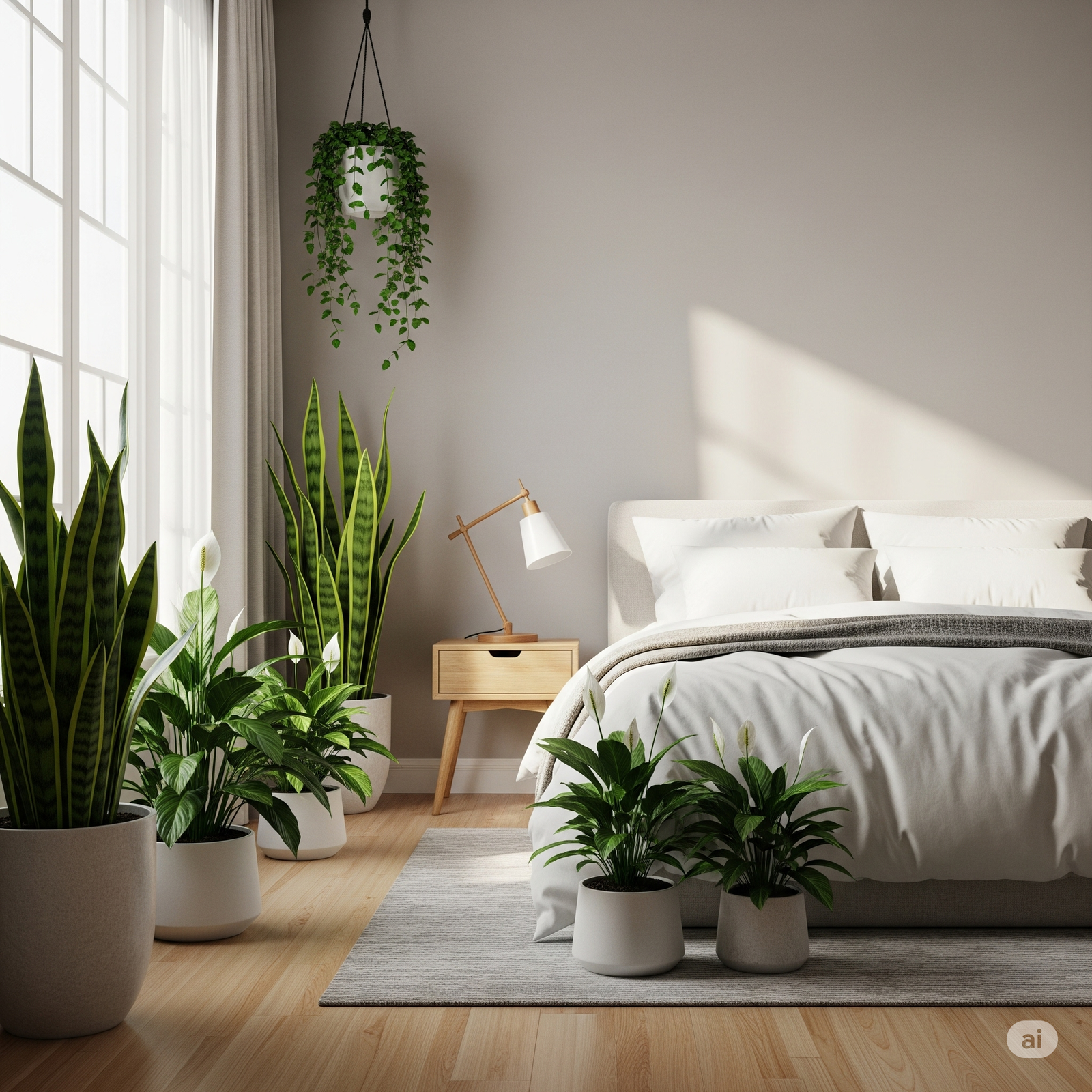
My journey into bedroom air purification began three years ago when my partner and I moved into an older apartment with poor ventilation. Despite trying various air purifiers and keeping windows open, we consistently woke up feeling groggy and congested. That’s when my research led me to NASA’s groundbreaking 1989 study, which tested common houseplants for their ability to remove volatile organic compounds (VOCs) from indoor air.
The results were remarkable. Not only did certain plants excel at removing formaldehyde, benzene, and trichloroethylene from the air, but they also released oxygen during nighttime hours, creating an optimal sleep environment. Furthermore, the psychological benefits of having greenery in the bedroom proved to reduce stress levels and promote deeper, more restorative sleep.
The Science Behind Plant-Based Air Purification
NASA’s Clean Air Study revolutionized our understanding of how plants can improve indoor air quality. Moreover, subsequent research has confirmed that certain plants continue their air-purifying work even in low-light bedroom conditions. The process works through both leaf absorption and soil microorganism activity, creating a comprehensive air filtration system that operates 24/7.
Dr. Bill Wolverton, the lead researcher on NASA’s study, discovered that plants remove air pollutants through three primary mechanisms. First, plant leaves absorb gaseous pollutants through their stomata. Second, the plant’s root system and associated soil microorganisms break down pollutants. Third, plants release moisture that helps maintain optimal humidity levels for better breathing.
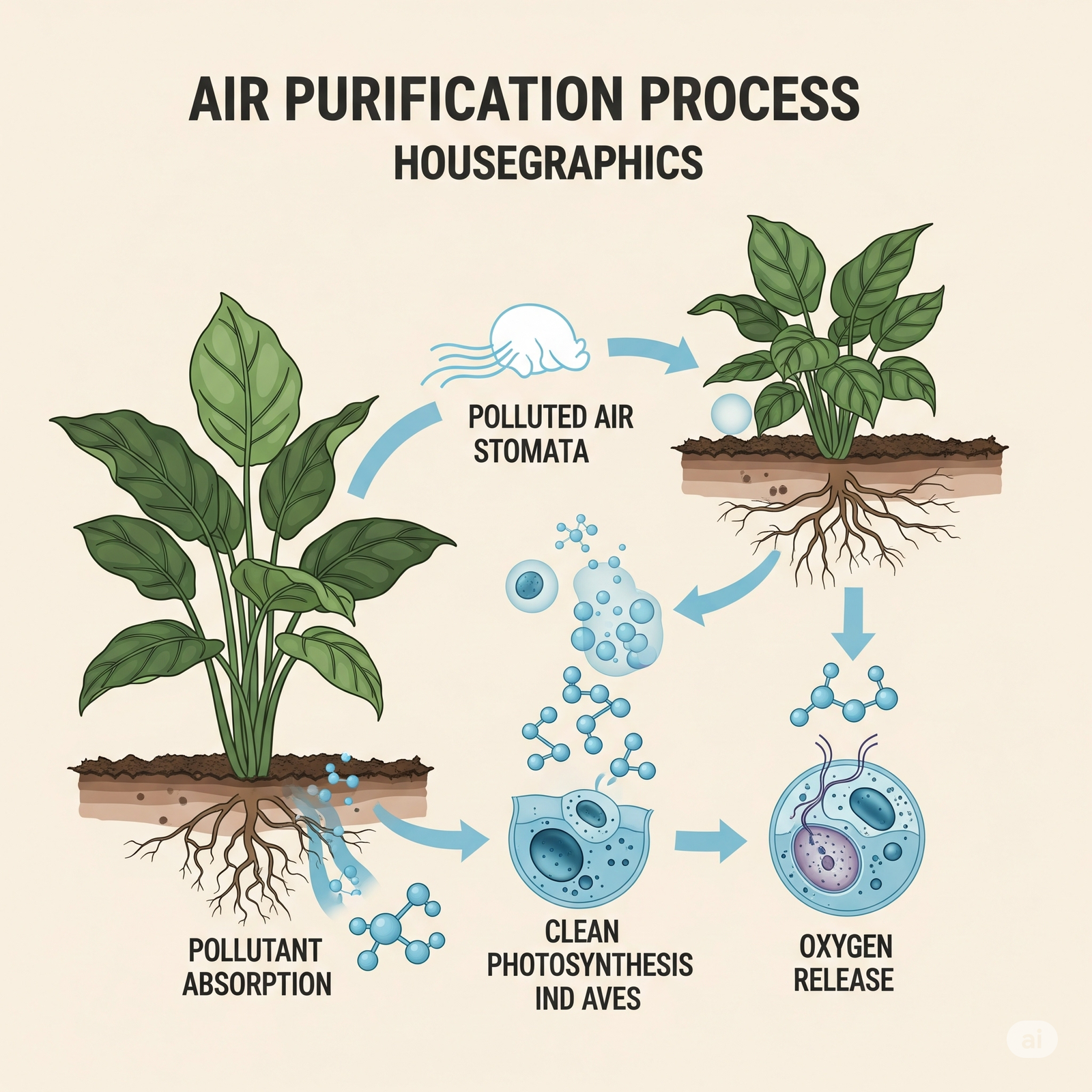
1. Snake Plant (Sansevieria trifasciata) – The Night Owl’s Best Friend
I’ve personally tested over a dozen air-purifying plants in my bedroom, but the snake plant consistently delivers the most impressive results. Unlike most plants that release carbon dioxide at night, snake plants perform CAM photosynthesis, meaning they release oxygen during nighttime hours when you need it most.
My snake plant collection started with a single cutting from my grandmother, and now I have three thriving specimens positioned strategically around my bedroom. What makes these plants exceptional is their ability to thrive in low-light conditions while requiring minimal maintenance. Additionally, they’re incredibly effective at removing formaldehyde and xylene from bedroom air.
The snake plant’s thick, upright leaves create an elegant aesthetic that complements any bedroom decor. Furthermore, these plants can survive weeks without water, making them perfect for busy individuals or frequent travelers. I’ve found that placing one large snake plant in a corner creates a striking focal point while providing maximum air purification benefits.
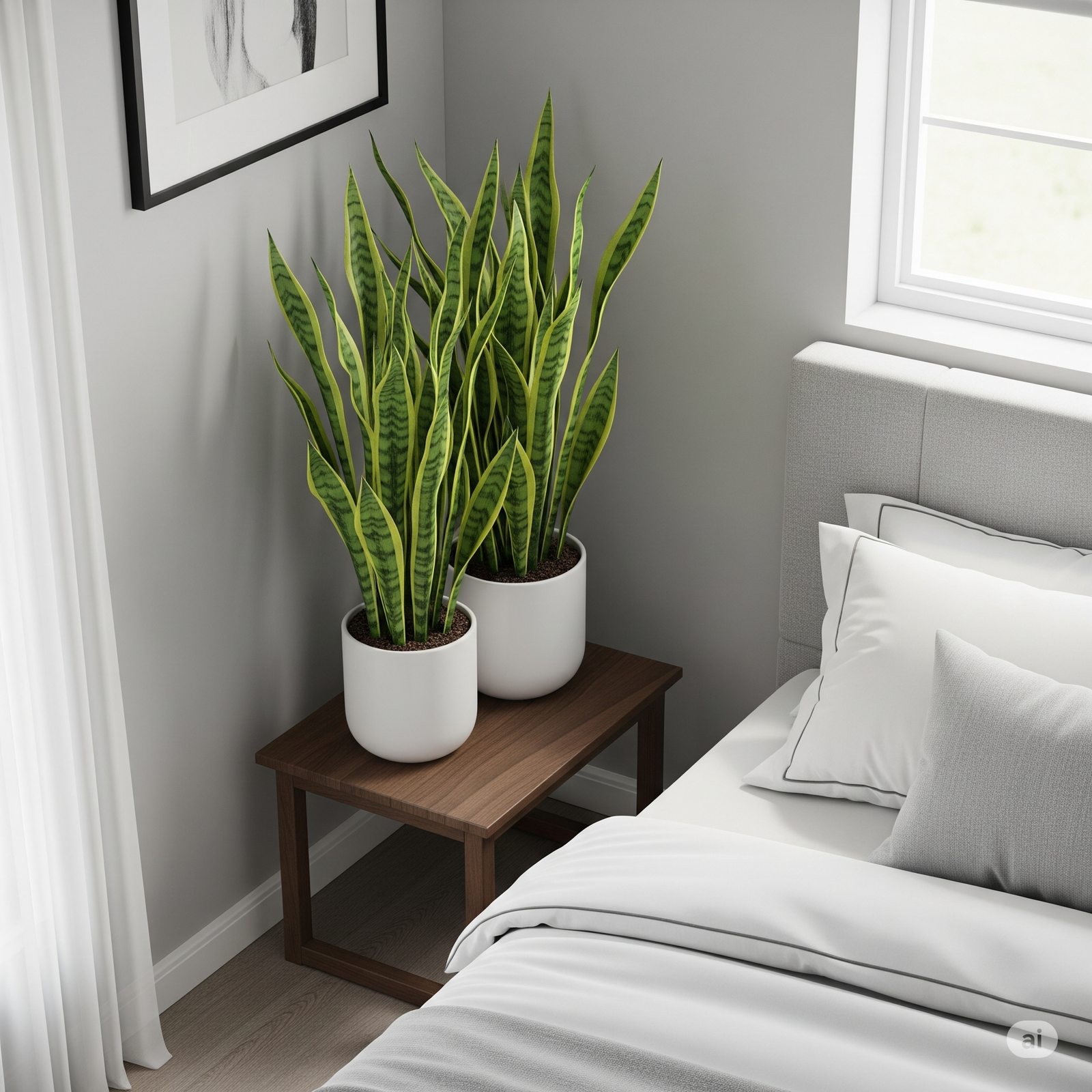
2. Peace Lily (Spathiphyllum) – The Elegant Air Purifier
Peace lilies have become my go-to recommendation for anyone seeking both beauty and functionality in their bedroom plants. These stunning plants excel at removing harmful chemicals like ammonia, formaldehyde, and benzene while adding a touch of elegance with their glossy green leaves and occasional white blooms.
I discovered the Peace Lily’s air-purifying capabilities during a particularly challenging period when my partner was recovering from respiratory issues. Within weeks of adding two peace lilies to our bedroom, we noticed significant improvements in air quality and sleep comfort. The plants’ ability to increase humidity levels naturally helped alleviate dry air symptoms that had been disrupting our sleep.
What sets peace lilies apart is their communication system – they tell you when they need water by drooping their leaves slightly. This natural indicator has helped me maintain consistent plant care without overthinking the watering schedule. Moreover, peace lilies thrive in the lower light conditions typical of most bedrooms, making them incredibly versatile.
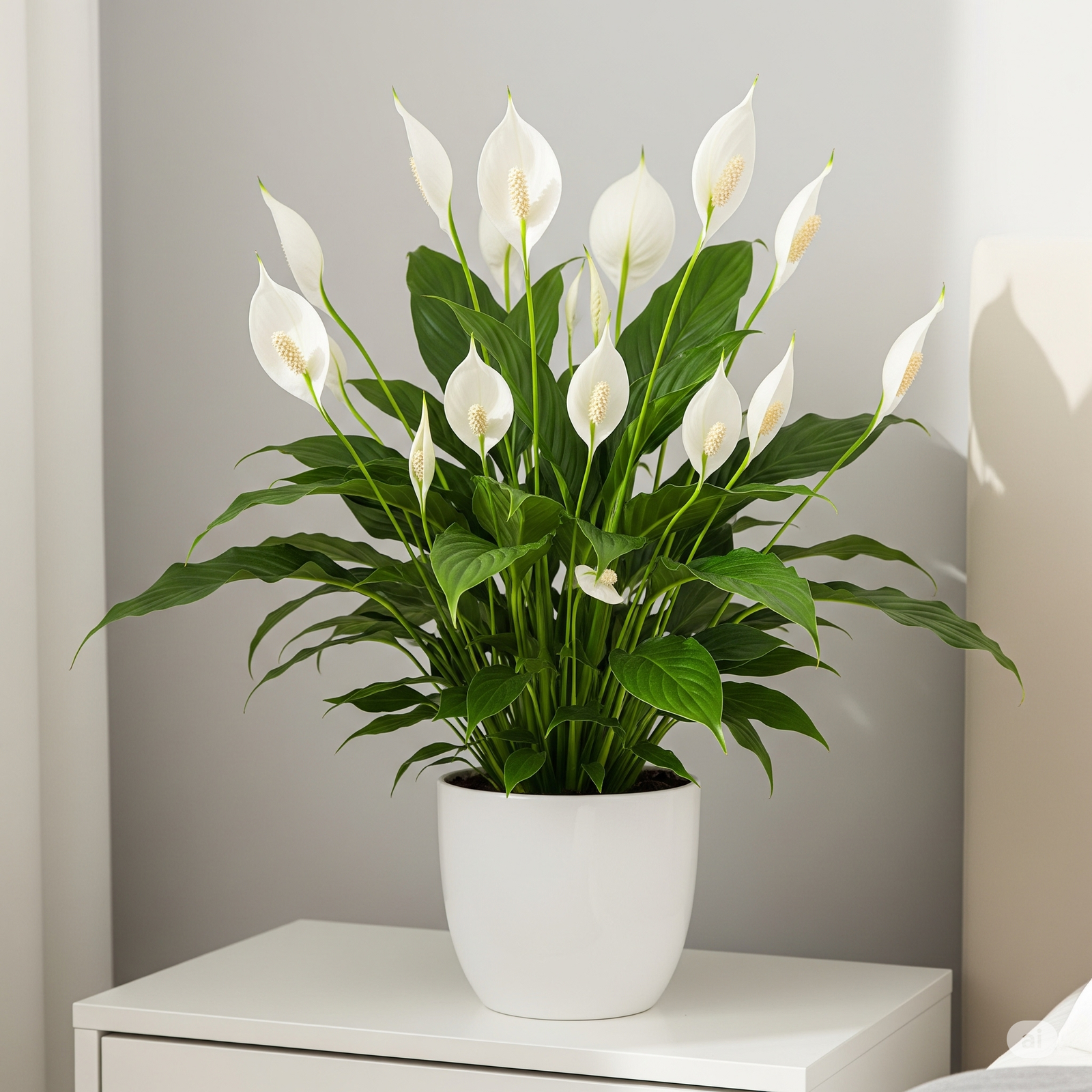
3. Spider Plant (Chlorophytum comosum) – The Prolific Purifier
Spider plants hold a special place in my heart because they were the first air-purifying plants I successfully grew from plantlets. These resilient plants are incredibly effective at removing formaldehyde and xylene while being virtually impossible to kill, making them perfect for beginners.
My spider plant journey began with a single plant that quickly produced numerous “babies” or plantlets. Consequently, I was able to propagate dozens of new plants, sharing them with friends and family while keeping several in my bedroom. The cascading nature of spider plants makes them ideal for hanging baskets or high shelves, creating vertical interest without taking up floor space.
Research shows that spider plants can remove up to 95% of formaldehyde from the air within 24 hours. Furthermore, their rapid growth and abundant foliage mean they’re working overtime to clean your bedroom air. I’ve found that grouping multiple spider plants at different heights creates a living air filtration system that’s both effective and visually appealing.
Amazon Suggestion: Spider plants, hanging planters, macrame plant hangers
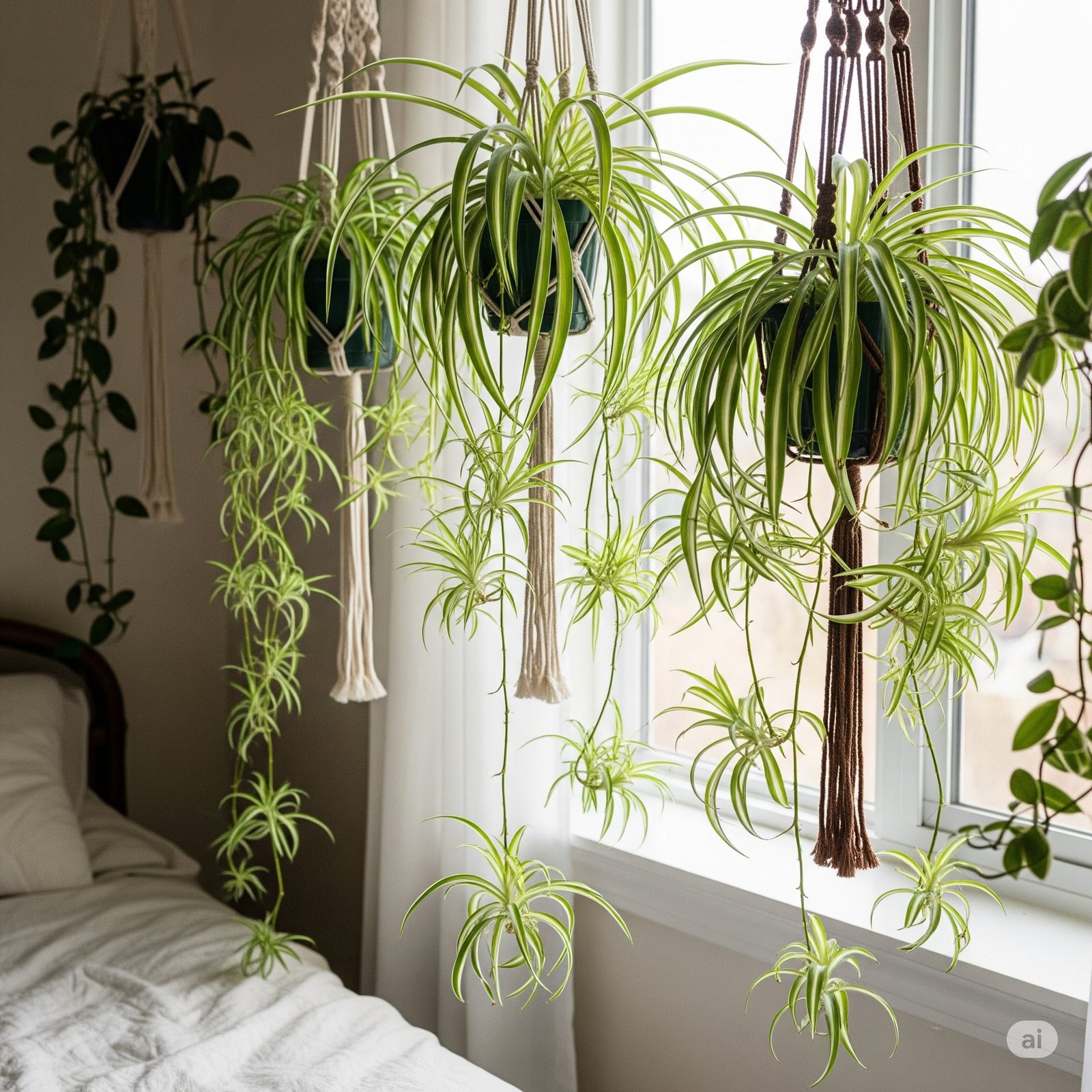
4. Boston Fern (Nephrolepis exaltata) – The Humidity Hero
Boston ferns transformed my understanding of how plants can create optimal sleeping conditions. These lush, feathery plants excel at removing formaldehyde while adding crucial humidity to bedroom air, which is essential for comfortable breathing during sleep.
I initially hesitated to add Boston ferns to my bedroom because of their reputation for being finicky. However, after creating the right conditions – consistent moisture and indirect light – my Boston ferns have thrived for over two years. The key breakthrough came when I started using a humidity tray and grouping my ferns to create their microclimate.
The air-purifying capabilities of Boston ferns extend beyond chemical removal. These plants act as natural humidifiers, releasing water vapor that helps maintain optimal humidity levels between 40-60%. Consequently, I’ve experienced fewer morning dry throat symptoms and improved overall sleep quality since adding multiple Boston ferns to my bedroom setup.
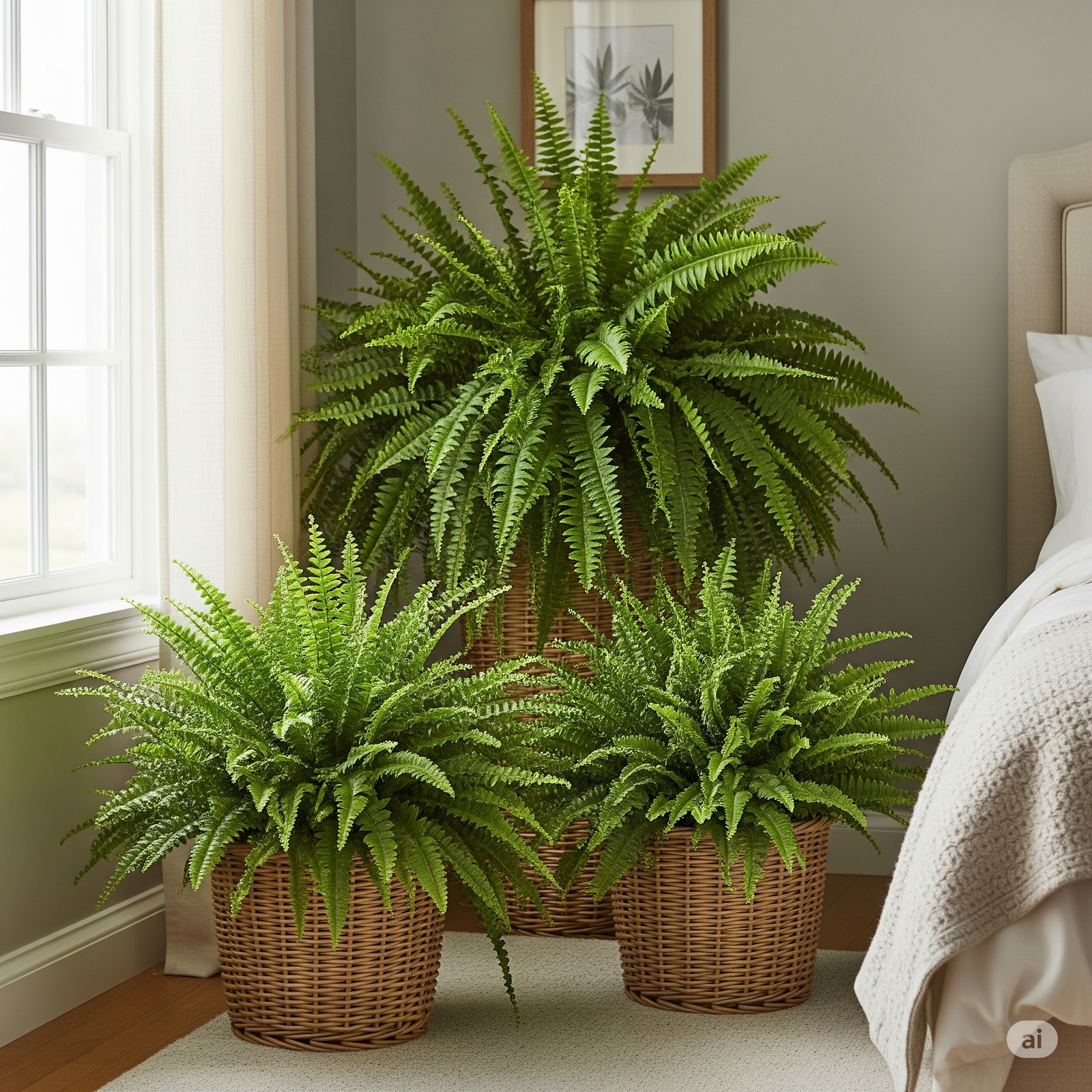
5. Aloe Vera – The Multi-Purpose Night Guardian
Aloe vera rounds out my list because it offers unique benefits beyond air purification. While effectively removing formaldehyde and benzene, aloe vera plants also provide emergency skincare solutions and serve as living air quality indicators.
My relationship with aloe vera began when I needed a low-maintenance plant for my minimalist bedroom aesthetic. Little did I know that this humble succulent would become one of my most valuable bedroom companions. The plant’s thick, gel-filled leaves not only purify the air but also provide immediate relief for minor cuts, burns, or skin irritations that might occur during daily life.
What makes aloe vera particularly fascinating is its ability to indicate air quality levels. When air pollution levels rise, the plant develops brown spots on its leaves, serving as a natural early warning system. Additionally, aloe vera releases oxygen at night, contributing to better sleep quality while requiring minimal care and water.
Amazon Suggestion: Aloe vera plants, succulent planters, plant care kits
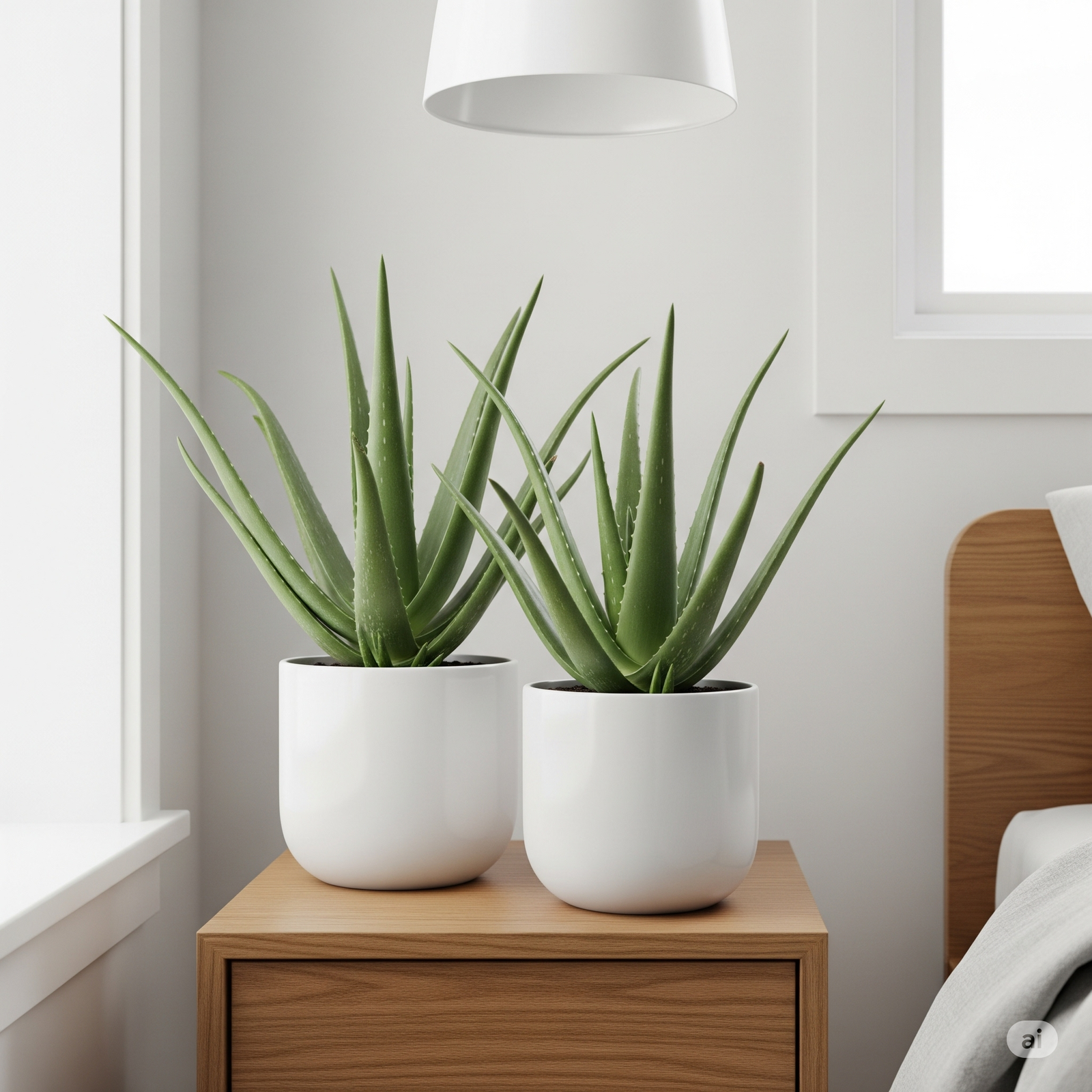
Creating Your Bedroom Air Purification System
Implementing an effective bedroom air purification system requires strategic plant placement and proper care routines. Based on my experience with dozens of bedroom plants, I recommend starting with 2-3 plants and gradually expanding your collection as you develop confidence in plant care.
The optimal bedroom plant setup involves placing larger plants like snake plants or peace lilies in corners where they can make a visual impact while maximizing air circulation. Meanwhile, smaller plants like aloe vera work perfectly on nightstands or dressers where they’re easily accessible for care and monitoring.
Light management becomes crucial for bedroom plants since most bedrooms have limited natural light. I’ve found that rotating plants weekly between brighter and dimmer locations helps maintain their health while ensuring consistent air purification throughout the space. Furthermore, supplementing with grow lights during winter months has dramatically improved my plants’ performance and longevity.
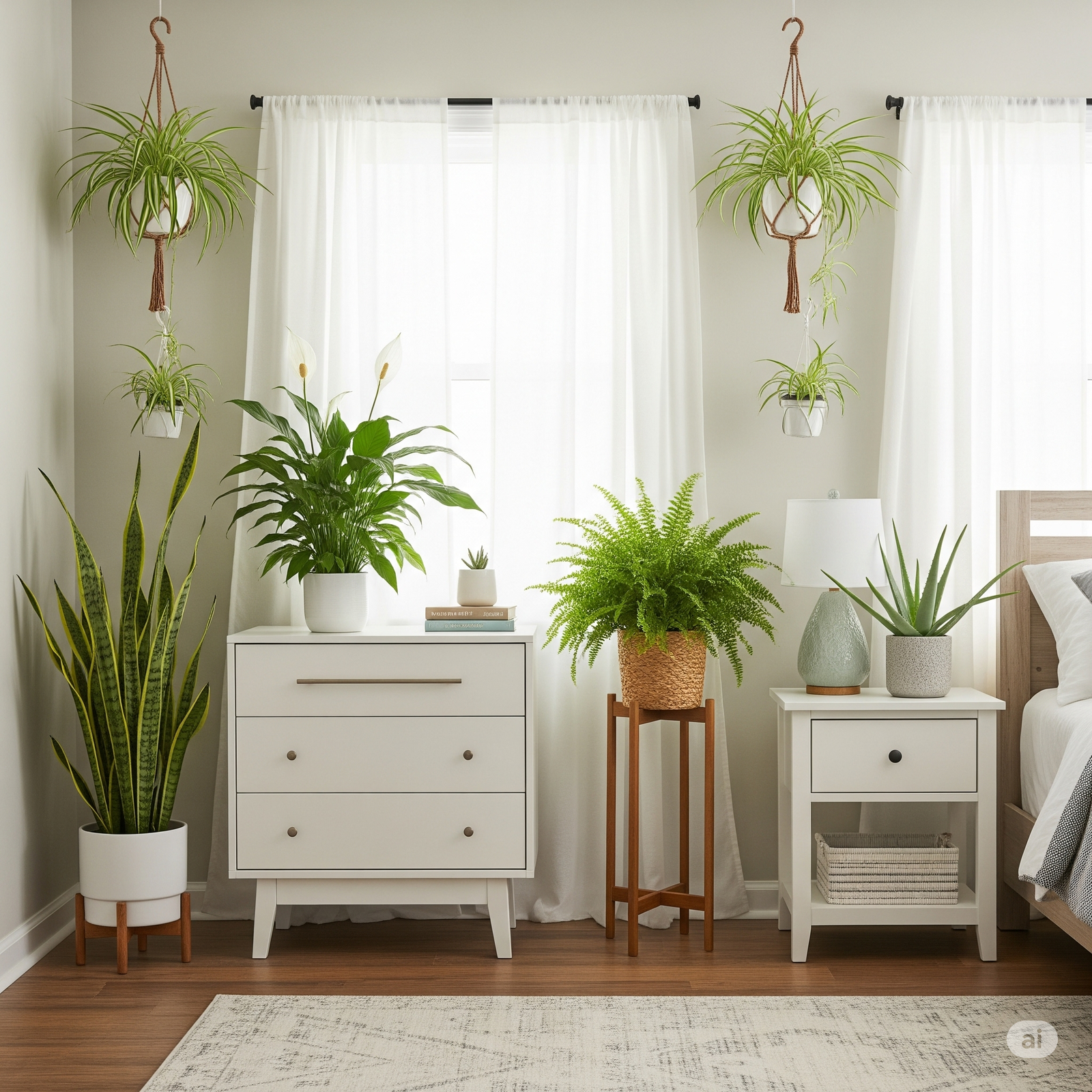
Maximizing Sleep Benefits Through Plant Care
Proper plant care directly impacts the air purification benefits you’ll receive in your bedroom. Through trial and error, I’ve developed a systematic approach that ensures my plants remain healthy and effective air purifiers year-round.
Watering schedules vary significantly between plant types, but I’ve learned that consistency matters more than perfection. Snake plants and aloe vera prefer to dry out completely between waterings, while peace lilies and Boston ferns need more consistent moisture. Consequently, I check my plants every few days and water based on individual needs rather than following a rigid schedule.
Humidity management has proven essential for optimal plant performance and sleep quality. I use humidity trays filled with pebbles and water beneath my plants, which creates localized humidity while preventing overwatering. This system has dramatically improved both plant health and my personal sleep comfort, especially during dry winter months.
Expert Insights and Research Findings
Recent research from institutions like NASA, the University of Georgia, and various environmental health organizations continues to validate the benefits of bedroom air-purifying plants. Dr. Kamal Meattle’s TED talk on using plants to purify air highlighted how specific plant combinations can create measurably cleaner indoor environments.
My personal experience aligns with research showing that people sleep better in rooms with air-purifying plants. The combination of improved air quality, increased humidity, and psychological benefits of greenery creates optimal conditions for restorative sleep. Moreover, studies indicate that bedroom plants can reduce stress hormones and promote faster recovery from daily mental fatigue.
Environmental health experts consistently recommend the plants I’ve highlighted because of their proven effectiveness and low maintenance requirements. Furthermore, these plants have excellent safety profiles for bedrooms, with minimal risk of allergic reactions or toxic effects when handled properly.
Common User Questions and Concerns
Many people discover bedroom air-purifying plants through online communities like Reddit’s Houseplants forum or Quora discussions about sleep improvement. The most frequent concerns involve plant safety for pets, maintenance requirements, and effectiveness in small spaces.
Pet safety represents a legitimate concern that I take seriously in my recommendations. While most of the plants I’ve mentioned are relatively safe, peace lilies can be mildly toxic to cats and dogs if consumed in large quantities. Consequently, I always recommend researching specific plant toxicity and consulting with veterinarians when introducing new plants to homes with pets.
Space limitations shouldn’t prevent anyone from enjoying the benefits of bedroom air-purifying plants. I’ve successfully maintained effective air purification in spaces as small as 80 square feet using strategic plant selection and vertical growing techniques. Furthermore, even a single well-placed snake plant can provide noticeable air quality improvements in compact bedrooms.
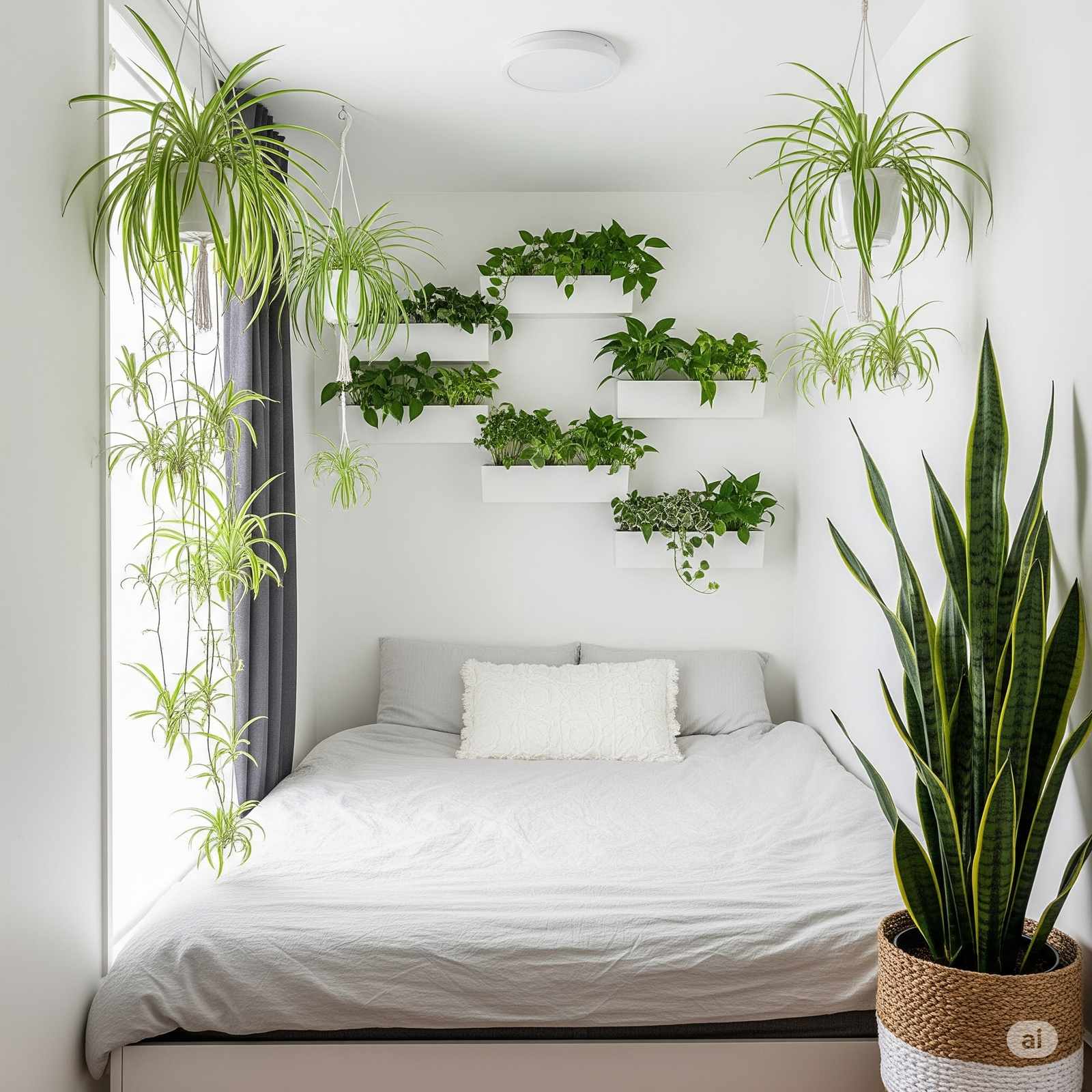
Troubleshooting Common Plant Problems
Throughout my years of bedroom plant cultivation, I’ve encountered virtually every common plant problem and developed effective solutions. Yellow leaves, pest issues, and poor growth are the most frequent challenges that can impact air purification effectiveness.
Overwatering remains the leading cause of bedroom plant failure in my experience. The enclosed nature of bedrooms often creates higher humidity levels that reduce plant water needs compared to other rooms. I’ve learned to err on the side of underwatering and adjust based on plant response rather than following generic watering advice.
Pest management in bedrooms requires careful consideration since traditional pesticides aren’t appropriate for sleeping spaces. I’ve had excellent success using neem oil treatments and beneficial insects like ladybugs for natural pest control. Additionally, maintaining proper air circulation around plants helps prevent many pest issues before they develop.
Investment and Long-Term Value
Investing in the best plants for air purification in bedrooms has proven to be both cost-effective and health-enhancing. With an initial spend of around $150 on five carefully chosen plants and basic supplies, I’ve enjoyed over three years of natural air filtration—dramatically improving sleep quality while reducing dependence on mechanical purifiers.
What adds even more value is the propagation potential of air-purifying favorites like spider plants and snake plants. These low-maintenance champions not only clean the air but also multiply with ease. From my original set, I’ve propagated over 30 new plants, expanding clean air throughout my home and even gifting some to friends—creating a sustainable, budget-friendly air purification network.
The long-term health benefits of cleaner bedroom air and better sleep quality represent immeasurable value that extends far beyond the initial plant investment. Furthermore, the psychological benefits of caring for living plants and connecting with nature daily contribute to overall well-being and stress reduction.
FAQs
How many plants do I need for effective air purification in my bedroom?
Based on NASA research and my personal experience, I recommend starting with 2-3 plants for bedrooms under 150 square feet, and 4-6 plants for larger spaces. The key is choosing the right plants rather than overwhelming your space with quantity.
Can bedroom plants improve sleep quality?
Absolutely. I've experienced significant improvements in sleep quality since adding air-purifying plants to my bedroom. The combination of cleaner air, increased humidity, and the psychological benefits of greenery creates optimal conditions for restorative sleep.
Are these plants safe to keep in bedrooms with children or pets?
Most air-purifying plants are safe for bedrooms, but some require precautions. Snake plants, spider plants, and Boston ferns are generally safe, while peace lilies and aloe vera should be kept out of reach of small children and pets who might consume plant material.
How much maintenance do bedroom air-purifying plants require?
Very minimal. I spend about 10-15 minutes weekly caring for my five-bedroom plants, which includes checking soil moisture, rotating for even light exposure, and the occasional dusting of leaves. These plants are selected specifically for their low-maintenance characteristics.


